1. Cusps of upper molars in three longitudinally arranged rows (Fig. 1): Family Muridae, 2
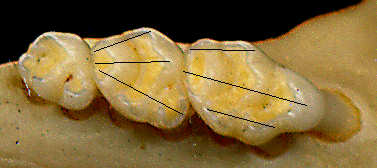
Fig. 1. Old World rat (Rattus) toothrow. The lines indicate the three rows of cusps typical of regional murids.
1'. Cusps of upper molars in two longitudinally arranged rows; Fig. 2, Family Cricetidae: 4

Fig. 2. New World cricetid (Neotoma) toothrow. The lines indicate the two rows that typically are present in the cricetid rodents.
2. Length of skull less than 20 mm: Mus musculus.
2'. Length of skull more than 20 mm: Rattus, 3
3. Temporal ridges more or less straight and parallel to one another as they cross the parietal bone; tail length usually less than length of head and body: Rattus norvegicus.
3'. Temporal ridges bowed laterally and diverging posteriorly as they cross the parietal bone; tail length as long as or longer than length of head and body: Rattus rattus.
4. Occlusal surface of each molar with a complicated pattern of triangular and other shaped figures outlined in enamel enclosing dentine lakes; occlusal surface flat (Fig. 3 and 4) or cusps forming strong lophs (Fig. 5): 5


Fig. 3 (left): Lower Microtus tooth (Arvicolinae), m1, anterior to left. Fig. 4 (right): Upper Neotoma teeth (Neotominae), M1-3, anterior to left
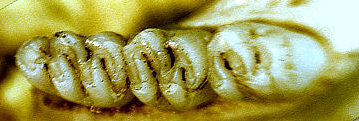
Fig. 5. Lower right toothrow of Sigmodon (Sigmodontinae), anterior to left.
4'. Occlusal surface of each molar with a series of bunodont cusps or lophs which may disappear with wear, leaving dentine lakes bordered with enamel; occlusal surface usually not
flat: Subfamily Neotominae (part) and Sigmodontinae, 19

Fig. 6 (left): Upper Peromyscus teeth, M1-3, anterior to left.
5. Dorsal border of infraorbital foramen forming a posteriorly directed notch when viewed from above; incisive foramina longer than occlusal surface of molars: Subfamily Neotominae (part) and Sigmodontinae: 6
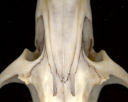
Fig. 7. Dorsal view of the infraorbital foramen of Neotoma (Neotominae).
5'. Dorsal border of infraorbital foramen not as above; incisive foramina shorter than occlusal surface of molars, narrower than distance between molar rows: Subfamily
Arvicolinae, 12

Fig. 8. Dorsal view of the same region of Microtus (Arvicolinae).
6. Molars with V-shaped reentrant angles; without conspicuous temporal ridges on parietal bones; ears prominent and naked; color pattern sharply bicolored: Neotoma, 7
6'. Molars without V-shaped reentrant angles; with conspicuous temporal ridges on parietal bones; ears partly hidden in fur and haired; color not sharply bicolored: Sigmodontinae Sigmodon, 33
7. Tail conspicuously bushy: Neotoma cinerea.
7'. Tail not conspicuously bushy: 8
8. Dorsal color steel gray in adults; nasal septum (vertical plate separating the internal nares) intact: Neotoma micropus.
8'. Dorsal color brown or tan in adults; nasal septum with a conspicuous posterior emargination: 9
9. Hairs of throat plumbeous basally (rarely a patch of hairs white to the base); anterointernal reentrant angle of upper M1 extending more than halfway across anterior lobe of tooth: Neotoma mexicana.
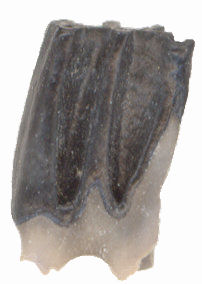 9'. Hairs of throat white basally; anterointernal reentrant angle of upper M1 extending
less than halfway across anterior lobe of tooth: 10
9'. Hairs of throat white basally; anterointernal reentrant angle of upper M1 extending
less than halfway across anterior lobe of tooth: 10
10. Tail with moderately long hairs, sometimes only vaguely bicolored; lingual fold of M3 as deep as or deeper than labial fold; nasals usually truncate posteriorly; anterolateral dentine tract well developed (Fig. 9): Neotoma stephensi.
Fig. 9. Lateral view of right m1 of a packrat (fossil Neotoma cinerea) showing the a prominent lateral dentine tract. Enamel has preserved dark; the ivory-colored material is dentine. The anterolateral dentine tract is to the far right.
10'. Tail with very short hairs, always sharply bicolored; lingual fold of M3 shorter than labial fold; nasals sharply pointed posteriorly; anterolateral dentine tract not extending more than 2 mm above base of lateral reentrant groove: 11.
11. Occurring west of the Rio Grande: Neotoma albigula
11'. Occurring east of the Rio Grande: Neotoma leucodon
12. Tail laterally compressed, long, scaly; condylobasal length more than 60 mm: Ondatra zibethicus.
12'. Tail rounded, hairy; condylobasal length less than 35 mm: 13
13. Cheek teeth rooted: 14
13'. Cheek teeth not rooted: 15
14. Dorsal color reddish: Myodes gapperi.
14', Dorsal color grayish or brownish: Phenacomys intermedius.
15. Tail about one-third or more of total length: Microtus longicaudus.
15'. Tail less than one-third total length: 16
16. M3 with four dentine lakes: Microtus ochrogaster.
16'. M3 with five dentine lakes: 17
17. M2 with four dentine lakes and a posterior accessory loop: Microtus pennsylvanicus.
17'. M2 with four dentine lakes but no posterior accessory loop: 18
18. Incisive foramina abruptly constricted posteriorly; color dark; tails of adults usually more than 35 mm: Microtus montanus.
18'. Incisive foramina broad and truncate posteriorly; color brown; tails of adults seldom attaining 35 mm: Microtus mogollonensis.
19. Upper incisors with a groove on anterior face: Reithrodontomys, 20
19'. Upper incisors without a groove: 22
20. Occlusal pattern of last lower molar S-shaped; occipitonasal length usually more than 22 mm; dorsal color usually rich golden brown: Reithrodontomys fulvescens.
20'. Occlusal pattern of last lower molar C-shaped; occipitonasal length usually less than 21 mm; color not golden brown: 21
21. Braincase breadth less than 9.7 mm; tail relatively short (usually less than one-half total length) and with narrow, distinct dorsal stripe: Reithrodontomys montanus.
21'. Braincase breadth more than 9.6 mm; tail longer (usually more than one-half total length), often not sharply bicolored, and dorsal stripe broader: Reithrodontomys megalotis.
22. Occipitonasal length of skull less than 22 mm; length of head and body less than 65 mm; length of hindfoot usually less than 20 mm: Baiomys taylori.
22'. Occipitonasal length of skull more than 22 mm; length of head and body more than 65 mm; length of hindfoot usually 20 mm or more: 23
23. Coronoid process relatively high and recurved; tail length less than 60 percent of length of head and body: Onychomys, 24
23'. Coronoid process relatively low, not strongly recurved; tail length more than 60 percent of length of head and body: Peromyscus, 26
24. Tail less than half the length of head and body; crown length of maxillary tooth-row 4.0 mm or more: Onychomys leucogaster.
24'. Tail more than half the length of head and body; crown length of maxillary tooth-row 3.9 mm or less: 25.
25. Posterior edge of palate concave or truncate; distribution west of continental divide near the New Mexico/Arizona border and to the west: Onychomys torridus
25'. Posterior edge of palate slightly convex to well developed spine; geographic distribution from Animas Valley and northwestern Chihuahua east through central and southern New Mexico: Onychomys arenicola
26. Two principal labial reentrant angles of first and second upper molars without (or, at best, with rudimentary) accessory tubercles or enamel loops: 27
26'. Two principal labial reentrant angles of first and second upper molars with accessory tubercles or enamel loops: 28
27. Tail well-haired and tufted; fur long and soft; nasals exceed premaxillae slightly or not at all: Peromyscus crinitus.
27'. Tail with extremely short hairs, almost naked, not tufted; nasals decidedly longer than premaxillae: Peromyscus eremicus.
28. Tail terete, that is, with no conspicuously elongate terminal hairs: 29
28'. Tail tufted, with terminal hairs that are conspicuously longer than others: 30
29. Hindfoot length 21 mm or less; greatest length of skull less than 27 mm; tail sharply bicolored: Peromyscus maniculatus.
29'. Hindfoot length more than 21 mm; greatest length of skull more than 27 mm; tail often not sharply bicolored: Peromyscus leucopus.
30. Ear usually 20 mm or less: 31
30'. Ear usually 20 mm or more: 32
31. Ankles white: Peromyscus pectoralis.
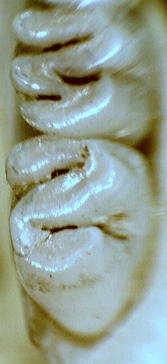 31'. Extension of dark dorsal coloration extending distally over
ankle: Peromyscus boylii.
31'. Extension of dark dorsal coloration extending distally over
ankle: Peromyscus boylii.
32. Length of ear longer than length of hindfoot on fresh specimens; tail length usually shorter than head and body length: Peromyscus truei, Peromyscus gratus (the two species are not easily separated on morphological data).
32'. Length of ear equal to or shorter than length of hindfoot; tail usually longer than head and body length: Peromyscus nasutus.
33. Venter ochraceous: Sigmodon fulviventer.
Fig. 10. Posterior portion of m2 and entire right m3 of Sigmodon showing the characteristic "S" cusp pattern.
33'. Venter not ochraceous: 34
34. Snout, eye-rings, and sometimes upper forelegs yellowish or orangish, total length usually less than 260 mm: S. ochrognathus.
34'. Snout, eye-rings, and upper forelegs not as above; total length often more than 260 mm: S. hispidus.
Key modified from Findley (1987).
Last Update: 6 Feb 2008